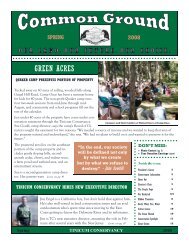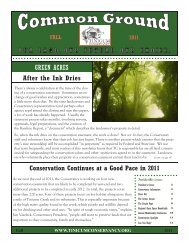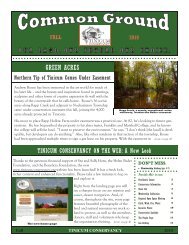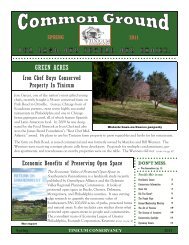Common Ground Newsletter - Tinicum Conservancy
Common Ground Newsletter - Tinicum Conservancy
Common Ground Newsletter - Tinicum Conservancy
You also want an ePaper? Increase the reach of your titles
YUMPU automatically turns print PDFs into web optimized ePapers that Google loves.
TC <strong>Newsletter</strong>-Spring '13-4-23-Replaced map and seal:TC Newesletter-Spring '13 4/23/13 6:30 PM Page 11<br />
Resource Protection Notes<br />
Thousand Cankers Disease and Emerald Ash Borer threaten important PA trees.<br />
Two pests are posing serious threats to<br />
Pennsylvania’s ash and black walnut<br />
populations, both of which are key<br />
components of the state’s forest<br />
ecosystems, landscapes, and hardwood<br />
industry. Thousand Cankers Disease<br />
and the Emerald Ash Borer have both<br />
been confirmed in Bucks County.<br />
Large-scale management and control<br />
options do not exist for either.<br />
shaped exit holes left by emerging<br />
adult beetles. Vertically split bark may<br />
appear over larval feeding galleries. As<br />
infestation takes hold, foliage wilts,<br />
branches die, and the canopy thins.<br />
Heavily infested trees may die within<br />
3-4 years. Individual trees can be<br />
treated with sprays and injections, at<br />
a cost of about $50 a year, per tree<br />
over many years, so there is an option<br />
leaves in mid-summer are two signs to<br />
look for. A thinning canopy from twig<br />
and branch dieback and ultimately<br />
thousands of cankers girdling the<br />
branches and trunk are further identifiers.<br />
No effective treatment exists for<br />
TCD.<br />
The public is encouraged to examine<br />
trees, know about state and federal<br />
quarantines and regulations, and follow<br />
Sticky, purple Emerald Ash Borer traps; D-shaped exit holes left by the 1/2” long beetle; the EAB and S-shaped larval tunnels under bark.<br />
Pennsylvania’s 300 million ash<br />
trees are under attack from the Emerald<br />
Ash Borer (EAB), a beetle native to<br />
Asia and first detected in North America<br />
in 2002. It has since spread to 14<br />
states and Canada, moving aggressively<br />
throughout Pennsylvania since discovery<br />
in 2007. The first known case in<br />
Bucks was documented in 2012.<br />
Infestations often go unnoticed,<br />
but one early sign is the appearance of<br />
jagged holes in the bark where woodpeckers<br />
feed on EAB larvae. Trunks<br />
and branches sometimes show D-<br />
for homeowners (or municipalities)<br />
with “high-value” trees.<br />
In 2011 the first case of Thousand<br />
Cankers Disease (TCD) in Pennsylvania<br />
was detected in a Plumstead Township<br />
black walnut. The black walnut’s<br />
extreme susceptibility to TCD and its<br />
prevalence in Pennsylvania and eastern<br />
forests generally means TCD is expected<br />
to have a severe impact. TCD<br />
is a disease complex—the combined<br />
work of a fungus and the walnut twig<br />
beetle. Tiny (2 mm) holes in the bark<br />
of branches, and wilting, yellowing<br />
the simple directive “Don’t Move Firewood”<br />
(or other raw wood) which limits<br />
the spread of all tree diseases.<br />
Much more information on detection,<br />
quarantines, and how to report<br />
suspected infestations can be found at:<br />
tinicumconservancy.org<br />
emeraldashborer.info<br />
thousandcankers.com<br />
dcnr.state.pa.us/forestry/insectsdisease<br />
An infected black walnut’s yellow, flagging leaves; the fungus-produced cankers; at 1.5 mm, the tiny walnut twig beetle is doing major damage.<br />
Spring 2013 TINICUMCONSERVANCY.ORG 11









